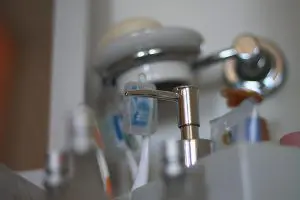Did you know every time you flush the toilet, there’s an invisible feces party in the air?
That’s right. Little microscopic pieces of your human waste spread throughout your bathroom like an aerosol and land on whatever object is nearby.

(wilkernet / pixabay)
We know what you’re thinking: “My toothbrush! It’s sitting out on the counter with an open invitation to that feces party.” And suddenly, you may not be so enthused about brushing.
As your Davis County dentist, we cannot stress this enough: keep brushing! An exposed toothbrush won’t kill you. In fact, there’s limited evidence to suggest that illness can be transmitted this way.
That said, there are other risks involved with storing your toothbrush improperly such as not allowing them to dry out (which can support bacteria growth), getting them too close to someone else’s toothbrush (for a massive germ swap), and compromising the bristles so that they no longer do their job.
Moving forward, there are some steps you can take to keep your toothbrush as clean and effective as possible. This will minimize contact with germs and eliminate the psychological ick factor so you can brush worry-free. It will also keep your toothbrush doing its job better and longer.
1. Close that lid when you flush
While feces vapor is not a significant risk to your toothbrush, it’s still one you want to minimize. If nothing else, this gives you greater peace of mind when you brush. Keep your toilet lid closed when you flush to inhibit the spread of poop vapor. While the chances of getting sick from your toothbrush being exposed to fecal matter are small, why not play it safe with this simple step?
2. Keep a safe distance
You should also place your toothbrush as far away from the toilet as you can—6 feet away is a safe bet, if possible.
3. Invest in a toothbrush holder
Toothbrush holders are designed to let your toothbrush dry out and keep the bristles intact. Plastic bags and travel containers hold moisture and increase the chance of bacteria growth. Bacteria will die out on a dry toothbrush. After brushing your teeth, put your toothbrush in the holder (handle down) and let it air dry. If you’re sharing the toothbrush holder with another family member, make sure that everyone’s brush stays separate from others.
4. Clean your toothbrush holder regularly
Clean your toothbrush holder regularly. This will help keep your toothbrush sanitary and free it of dust, toothpaste buildup and any other gunk that may be lingering.
5. Sharing is not Caring
Swapping pathogens is not cool. Make sure everyone in your household has their OWN toothbrush. Perhaps each member has a different color to avoid getting them mixed up? Sharing toothbrushes is not sanitary and increases the risk of infection. Refer to the toothbrush holder tip above for storing toothbrushes separately from others. The last thing you want is someone’s toothbrush juice dripping onto yours.
6. Skip the Medicine Cabinet
A closed medicine cabinet is actually not the ideal place for your toothbrush. Your toothbrush won’t have the open air to dry off, and instead, it becomes a damp environment, suitable for germs to grow and thrive.
7. Rinse it Well after You Brush
Rinse your toothbrush off with water after you brush your teeth thoroughly to avoid those dreaded cavities. Don’t let any leftover toothpaste camp out on your toothbrush and dry into crusty old toothpaste (yuck).
8. Replace it Every Three Months
A toothbrush tends to be good for three months, four at the most. Get in the habit of swapping it out regularly. Otherwise, the bristles tend to get frayed and don’t work as effectively. Consider setting a reminder on your phone to keep you on track with replacements.
9. Don’t Chew on it
Try to refrain from chewing, sucking, or gnawing on your toothbrush bristles. Doing so can damage the follicles and cause micro-tears and abrasions that can host yucky bacteria. Avoid these bad habits to ensure your toothbrush is sanitary.
Storing Your Toothbrush for Travel
You can break the rules a little when traveling. While traveling, it’s best to store your toothbrush in a travel toothbrush cap or holder to keep your bristles away from everything else in your bag. Try to purchase one that has at least some small openings for ventilation.
When you get back, don’t keep it in your travel bag long-term because, as we mentioned earlier, you should let it dry out to prevent bacteria that tend to thrive in damp environments.
Best Ways to Clean Your Toothbrush
- Rinse before and after every use
- Soak it in hot water, vinegar, and baking soda for 10-15 minutes, then rinse off
- Soak in one teaspoon of peroxide and one cup of water for 10-15 minutes, then rinse off
- Soak in mouthwash (only on occasion)
Oral health is essential. Germs are yucky. Bacteria is the enemy.
Brushing and flossing every single day is crucial. We put our toothbrushes in our mouths every day, so putting some energy into how you store them and keep them clean is essential.
As your Utah family dentist, we have a passion for educating our patients and helping them to keep up with their oral health inside and outside of the dental office. Call us with any questions you may have about dental health!
